外研版(2019)选择性必修 第二册Unit 3 Times change! Developing ideas 语言点 课件(共25张)
文档属性
| 名称 | 外研版(2019)选择性必修 第二册Unit 3 Times change! Developing ideas 语言点 课件(共25张) | 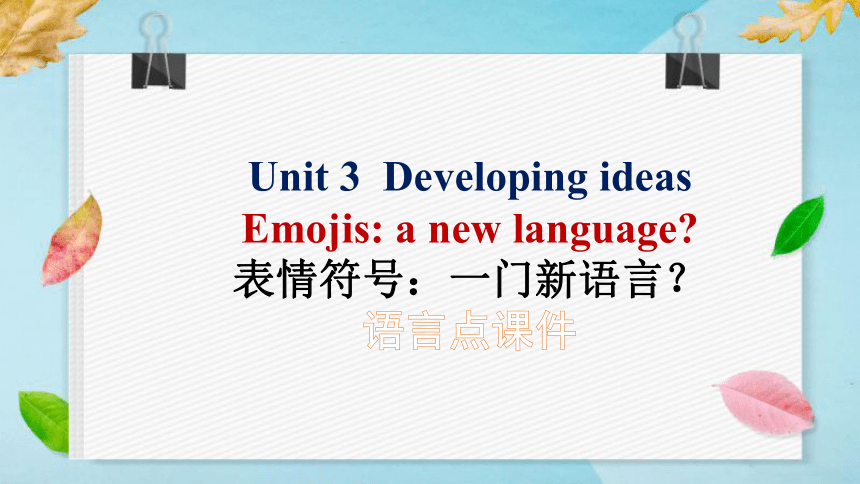 | |
| 格式 | pptx | ||
| 文件大小 | 645.2KB | ||
| 资源类型 | 教案 | ||
| 版本资源 | 外研版(2019) | ||
| 科目 | 英语 | ||
| 更新时间 | 2024-11-21 11:34:02 | ||
图片预览


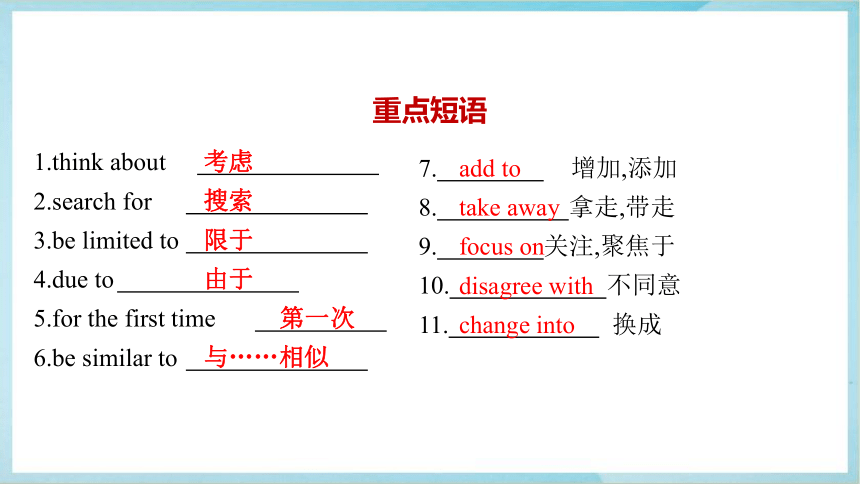
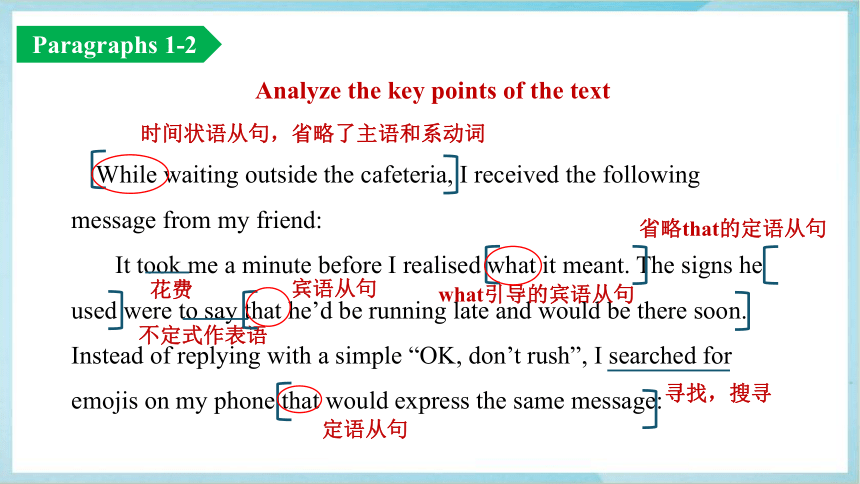
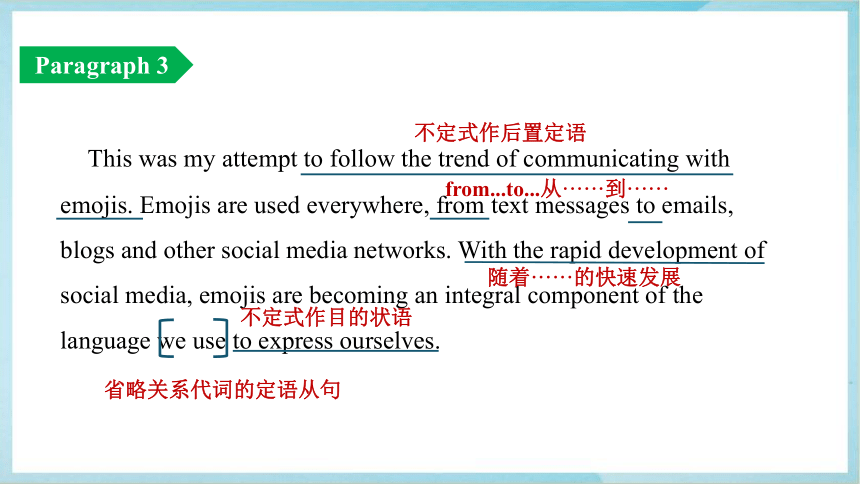

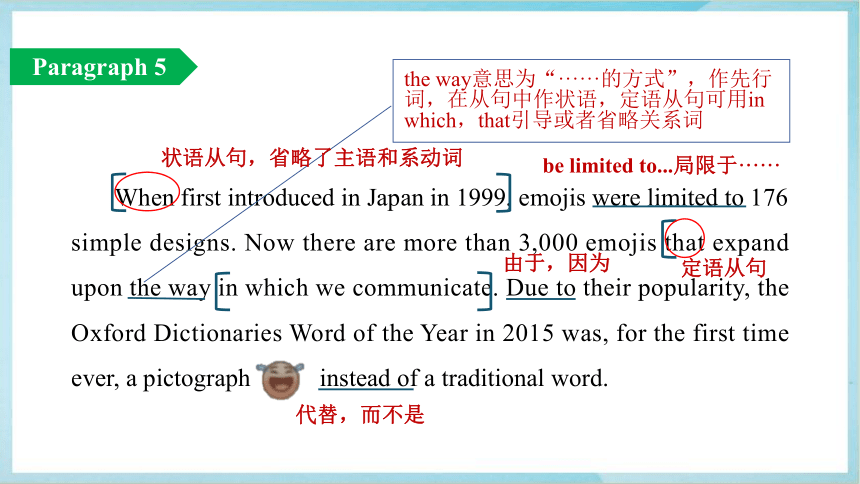


文档简介
(共25张PPT)
Unit 3 Developing ideas
Emojis: a new language
表情符号:一门新语言?
语言点课件
拓展词汇
1. adj.情绪(上)的,情感(上)的→ n.情绪;情感
2. n.意图,目的→ v.打算;想要
3. n.改编→ v.改编
4. adj.易懂的→ v.可获得 n.途径
5. n.教育工作者;教育学家→ v.教育
6. adv.紧急地;急迫地→ adj.紧急的→
n.紧急,紧急情况
7. adj.有说服力的,使人信服的→ v.使信服
emotional
emotion
intention
intend
adaptation
adapt
accessible
access
educator
educate
urgently
urgent
urgency
convincing
convince
重点短语
1.think about
2.search for
3.be limited to
4.due to
5.for the first time
6.be similar to
考虑
搜索
限于
由于
第一次
与……相似
7. 增加,添加
8. 拿走,带走
9. 关注,聚焦于
10. 不同意
11. 换成
add to
take away
focus on
disagree with
change into
While waiting outside the cafeteria, I received the following message from my friend:
It took me a minute before I realised what it meant. The signs he used were to say that he’d be running late and would be there soon. Instead of replying with a simple “OK, don’t rush”, I searched for emojis on my phone that would express the same message:
时间状语从句,省略了主语和系动词
花费
what引导的宾语从句
省略that的定语从句
不定式作表语
宾语从句
寻找,搜寻
定语从句
Paragraphs 1-2
Analyze the key points of the text
This was my attempt to follow the trend of communicating with emojis. Emojis are used everywhere, from text messages to emails, blogs and other social media networks. With the rapid development of social media, emojis are becoming an integral component of the language we use to express ourselves.
不定式作后置定语
from...to...从······到······
随着······的快速发展
省略关系代词的定语从句
不定式作目的状语
Paragraph 3
The word “emoji” comes from Japanese, literally meaning “picture character”. Emojis are small symbols representing ideas, emotions or feelings. They come in different categories, such as faces and people, plants and animals, and food and drink.
来自
现在分词短语作伴随状语
现在分词短语作后置定语
Paragraph 4
When first introduced in Japan in 1999, emojis were limited to 176 simple designs. Now there are more than 3,000 emojis that expand upon the way in which we communicate. Due to their popularity, the Oxford Dictionaries Word of the Year in 2015 was, for the first time ever, a pictograph instead of a traditional word.
状语从句,省略了主语和系动词
be limited to...局限于······
定语从句
由于,因为
代替,而不是
Paragraph 5
the way意思为“······的方式”,作先行词,在从句中作状语,定语从句可用in which,that引导或者省略关系词
In today’s world, emojis have become more and more popular.
It seems that emojs have clear advantages over written language. People like them because they add emotional meaning, and are quick and easy to use. In fact, this is similar to the gestures we use when we speak. With a smiling or sad face added to a message or post, your reader can “see” your facial expression while reading your words. Emojis can also help people express their feelings when they cannot find the appropriate words. For instance, if your friend is moving across the country, you may just send them a string of crying faces to express your sadness over your separation.
“似乎,好像”
“在······方面有明显的优势”
引导原因状语从句
“与······相似”
“例如”
with+宾语+过去分词作宾补
时间状语从句的省略结构
时间状语从句
引导条件状语从句
Paragraph 6
The use of emojis has even spread to classical literature. Shakespeare series for young readers has taken William Shakespeare’s popular plays and replaced some words with textspeak and emojis. The intention of these adaptations is to make the classics more accessible to young readers. Some people, however, believe that these new versions have taken away the heart and soul of Shakespeare’s plays.
现在完成时
replace…with…用······替代······
不定式作表语
易懂的
副词,然而
宾语从句
Paragraph 7
As we can see, emojis have a tendency to pop up all over the place. Users of emojis say that they facilitate the way in which we communicate and express ourselves. But this makes others, especially educators, worry that we are losing the ability to communicate properly using the written word, or even the spoken word. After all, how many of us today would rather send a message packed with emojis than make a telephone call Perhaps people will one day choose to communicate in pictures, and forget how to write properly. On that day, emojis will have become a real pictorial “language”. But, for now, maybe it’s best that we just enjoy using them.
as 引导非限制定语从句
有做某事的倾向
先行词在从句中作状语,in which 引导定语从句
make+宾语+宾补
······的能力
现在分词作方式状语
毕竟
enjoy doing...享受做某事
后置定语
“疑问代词+不定式”
would rather do...than do“宁愿做······而不愿做······”
Paragraph 8
1. reply with
2. search for
3. attempt
4. When first introduced...
5. expand
6. advantage
7. a string of
8. spread
9. adaptation
10. soul
11. tendency
12. convenient
词、短语及句型
1
reply with 以……作答 ;以……回复
Please reply with prices. 请回复价格。
He never did reply with words. 他从没有用言语回答过我。
If you listen to the idea, and you are a good listener, you need to reply with constructive feedback.
如果你听到了这个建议,而你又是一个好的倾听者,那么你需要提供建设性的回馈。
Instead of replying with a simple“OK,don’t rush”,I searched for emojis on my phone that would express the same message:(P32)我没有简单地回复“好,别着急”,而是从手机上搜索了几个表达相同意思的表情符号:
2
◆ search for 寻找;搜索;搜查
They want to search for information,to communicate with others and to have fun.他们想寻找信息,与他人交流,享受乐趣。
The rescuers are still in search of the missing people in the flash floods.
救援人员仍在寻找山洪暴发中失踪的人。
I searched the whole room for the lost key,but in vain.
我搜遍了整个房间寻找丢失的钥匙,但没有找到。
search for 寻找;搜索;搜查
Instead of replying with a simple “OK, don’t rush”,
I searched for emojis on my phone that would express the same message:(P32)我没有简单地回答“好吧,别着急”,而是在手机上搜索能表达同样信息的表情符号:
【词汇拓展】
in search of 寻找;搜寻;寻求
in one’s search for寻找
search sth./sb.搜查某物/搜身
search...for...为找到……而搜查……
3
attempt n.& vt. 尝试;努力;试图
This was my attempt to follow the trend of communicating with emojis.
这是我试图追随用表情符号交流的趋势。(P32)
◆ attempt n.& vt.尝试;努力;试图
I have persuaded him to give up the attempt.我已经说服他放弃这种尝试了。
They attempted to finish the task in advance.他们试图提前完成这项任务。
I passed my driving test at the first attempt.我第一次考驾照就通过了。
【词汇拓展】
make an attempt/attempts to do/at doing sth. 尝试/试图做某事
in an attempt to do sth. 试图做某事
at the first attempt 首次尝试
attempt to do sth. 尝试做某事
4
When first introduced... 是状语从句省略结构
When first introduced in Japan in 1999,emojis were limited to 176 simple designs. 1999年首次在日本推出时,表情符号仅限于176个简单的图案。(P33)
【句型分析】在该句子中When first introduced in Japan in 1999是状语从句的省略,补全后为:When emojis were first introduced in Japan in 1999。
If admitted,I will do all I can to do the work well.
如果我能被录用,我一定会努力把工作做好的。
Whenever (it is) possible,they would stop him and ask him the three questions.
可能的话,他们就让他停下来问他这三个问题。
What action,if any,do you take 若有的话,你会采取什么措施
【句型拓展】
(1)当状语从句的主语和主句的主语一致,且从句中含有be动词时,可将从句的主语
和be动词一起省略。
(2)当从句中含有it + be时,可将it和be省略。
(3)掌握下列短语: if any如果有的话; if so如果是这样的话; if ever如果曾经有的话;
if not如果不这样的话;when necessary如果必要的话。
5
expand vi.& vt. 扩展,发展(业务);扩大,增强
Now there are more than 3,000 emojis that expand upon the way in which we communicate.现在有3 000多种表情符号,丰富了我们交流的方式。(P33)
◆ expand vi.& vt.扩展,发展(业务);扩大,增强
He wanted to increase rice harvests without expanding the area of the fields.
他想在不扩大田地面积的情况下增加水稻收成。
We’ve expanded the business by opening two more stores.
我们增开了两个商店以扩展业务。
The village expanded into/to a town.这个村子发展成了一个镇。
I’ll expand on this problem at the next meeting.
我将在下次会议上详谈这个问题。
【词汇拓展】
expand into/to 使扩大,变大,将……扩展(充)成……
expand on/upon 详述;详细阐明
6
advantage n. 优点;有利因素
It seems that emojis have clear advantages over written language.
与书写语言相比,表情符号似乎有明显优势。(P33)
◆ advantage n.优点;有利因素
She had the advantage of a good education.她具有受过良好教育的有利条件。
Many young people are at a disadvantage in the job market,particularly in developing countries.很多年轻人特别是发展中国家的年轻人在就业市场上处于劣势。
Please bring out the advantages and disadvantages of living in the countryside.请说出住在乡下的利弊。
You may wish to take advantage of our courses.你应该充分利用我们的课程。
【词汇拓展】
take advantage of 利用
win/have an advantage over 胜过
advantages and disadvantages 利与弊
at a disadvantage 处于不利地位
7
a string of 一系列,一串;一连串的
She wore a string of pearls at her throat/around her neck.
她那时脖子上带着一串珍珠。《柯林斯英汉双解大词典》
A string of flowers is put over a friend’s neck.
朋友的脖子上戴着一串花。
The landscape is broken only by a string of villages.
这风景仅仅是被一排村庄所破坏。《柯林斯英汉双解大词典》
They held a string of military bases in west Africa.
他们在西非拥有一系列军事基地。
8
spread to(to get larger and affect more people or a larger area) 传到,蔓延到;传播到
It appears the bad weather has spread to the coast.
看来恶劣的天气已经蔓延到沿海地区。
The cancer has spread to his stomach.
癌已扩散到他的胃部。《牛津词典》
The fire rapidly spread to neighbouring buildings.
大火已蔓延到了邻近的建筑物。
The festival spread to China as early as the 1980s and was widely accepted.这个节日早在20世纪80年代传到中国,并被广泛接受。
In adddition to its presence in China,Beijing Opera has spread to many other places.
除了在中国,京剧还传播到许多其他地方。
9
adaptation n. 改编本, 改写本; 适应
The intention of these adaptations is to make the classics more accessible to young readers.这些改编本的目的是让经典更容易被年轻读者理解。(P33)
◆ adaptation n. 改编本,改写本;适应
It is an adaptation of a novel for television.
这是一部由小说改成的电视剧。
Don’t worry. I need a period of adaptation.
不要担心,我需要一段适应期。
The culture made it hard for him to adapt to the new environment abroad.文化使得他很难适应国外的新环境。
The TV plays adapted from adventure stories caught the imagination of many a young viewer.根据冒险故事改编的电视剧激发了很多年轻观众的想象力。
Three of her novels have been adapted for TV series.
她的小说中有三部已被改编成了电视剧。
【词汇拓展】
adapt vi.& vt.改编;适应
adapt to... 适应……
adapt...to... 使适应或适合…
adapt oneself to... 使自己适应或者习惯于……
adapt...from...根据……改写(改编)
adapt...for...改编/改作……之用
adaptable adj.能适应的;可修改的
10
soul n. 灵魂,精神
【词汇拓展】
bare one’s soul (to sb.) (向某人)打开心扉,倾诉衷肠
body and soul 竭尽全力;全心全意
heart and soul 满腔热情地;全力地
Some people,however,believe that these new versions have taken away the heart and soul of Shakespeare’s plays.
然而,有些人认为,这些新版本夺走了莎士比亚戏剧的核心与灵魂。(P33)
◆ soul n.灵魂,精神
Reading books can broaden the mind,touch the heart,and enrich the soul.
读书可以开阔眼界,触动心灵,丰富灵魂。
We’ll support you heart and soul in your new experiment.
我们将会全力地支持您进行新的实验。
11
tendency n. 趋势
As we can see,emojis have a tendency to pop up all over the place.
正如我们所看到的,表情符号有一种到处流行的趋势。(P33)
◆ tendency n.趋势
There is a tendency to think of each of the arts as a separate area of activity.
目前有一种趋势,认为每一种艺术形式都是独立的领域。
I have a tendency to talk too much when I’m nervous. 我紧张时总爱唠叨。
Lacking necessary social experience,teenagers tend to be taken in by cheaters.由于缺乏必要的社会经验,青少年很容易上当受骗。
【词汇拓展】
have a tendency to do sth. 有做某事的倾向
tend to/towards 趋向/倾向于
tend to sb./sth. 照料, 照看某人/某事
tend to do sth. 易于/往往会做某事
12
convenient adj. 方便的,便利的;合适的
It is certainly more convenient to take out a mobile and make a call at the touch of a button than to press a series of long numbers on a telephone.比起在电话上按一系列长号码, 用手机点一下按键打电话当然更方便。(P35)
◆ convenient adj.方便的,便利的;合适的
We must arrange a convenient time and place for the meeting.
我们必须安排一个合适的时间和地点开会。
We hope that you will accept our invitation if it is convenient for you.
如果您方便的话,我们希望您能接受我们的邀请。
Please send me an answer at your convenience.
请你在方便的时候给我一个答复。
It is a great convenience to have the school so near.附近有一所学校,真是方便。
【词汇拓展】
convenience n. 方便,便利
for convenience 为了方便起见
at one’s convenience 在某人方便的时候
be convenient to/for... 对……是方便的
It is convenient (for sb.) to do sth. (某人)做某事方便
1. reply with
2. search for
3. attempt
4. When first introduced...
5. expand
6. advantage
7. a string of
8. spread to
9. adaptation
10. soul
11. tendency
12. convenient
以……作答 ;以……回复
寻找;搜索;搜查
n.& vt. 尝试;努力;试图
是状语从句省略结构
vi.& vt. 扩展,发展(业务);扩大,增强
n. 优点;有利因素
一系列,一串;一连串的
传到,蔓延到;传播到
n. 改编本, 改写本; 适应
复习回顾
n. 灵魂,精神
n. 趋势
adj. 方便的,便利的;合适的
Nowadays “emojis” are used everywhere. The word “emoji” comes 1. Japanese, literally meaning “picture character”. When first
2. (introduce) in Japan in 1999, emojis 3.____________ (limit) to 176 simple designs. Now there 4. (be) more than 3,000 emojis that expand upon the way in 5. we communicate. In today’s world, emojis 6._____________(become) more and more popular. The use of emojis has even spread to 7. ________(classic) literature, which makes the classics more 8. __________(access) to young readers. However, some people think these new 9.___________ (version) have taken away the heart and soul of Shakespeare’s plays. Emojis will have become a real pictorial “language”. 10._____ for now, maybe it’s best that we just enjoy using them.
Nowadays “emojis” are used everywhere. The word “emoji” comes 1. Japanese, literally meaning “picture character”. When first
2. (introduce) in Japan in 1999, emojis 3.____________ (limit) to 176 simple designs. Now there 4. (be) more than 3,000 emojis that expand upon the way in 5. we communicate. In today’s world, emojis 6._____________(become) more and more popular. The use of emojis has even spread to 7. ________(classic) literature, which makes the classics more 8. __________(access) to young readers. However, some people think these new 9.___________ (version) have taken away the heart and soul of Shakespeare’s plays. Emojis will have become a real pictorial “language”. 10._____ for now, maybe it’s best that we just enjoy using them.
from
introduced
were limited
are
which
have become
classical
accessible
versions
But
from
introduced
were limited
are
which
have become
Summary
Unit 3 Developing ideas
Emojis: a new language
表情符号:一门新语言?
语言点课件
拓展词汇
1. adj.情绪(上)的,情感(上)的→ n.情绪;情感
2. n.意图,目的→ v.打算;想要
3. n.改编→ v.改编
4. adj.易懂的→ v.可获得 n.途径
5. n.教育工作者;教育学家→ v.教育
6. adv.紧急地;急迫地→ adj.紧急的→
n.紧急,紧急情况
7. adj.有说服力的,使人信服的→ v.使信服
emotional
emotion
intention
intend
adaptation
adapt
accessible
access
educator
educate
urgently
urgent
urgency
convincing
convince
重点短语
1.think about
2.search for
3.be limited to
4.due to
5.for the first time
6.be similar to
考虑
搜索
限于
由于
第一次
与……相似
7. 增加,添加
8. 拿走,带走
9. 关注,聚焦于
10. 不同意
11. 换成
add to
take away
focus on
disagree with
change into
While waiting outside the cafeteria, I received the following message from my friend:
It took me a minute before I realised what it meant. The signs he used were to say that he’d be running late and would be there soon. Instead of replying with a simple “OK, don’t rush”, I searched for emojis on my phone that would express the same message:
时间状语从句,省略了主语和系动词
花费
what引导的宾语从句
省略that的定语从句
不定式作表语
宾语从句
寻找,搜寻
定语从句
Paragraphs 1-2
Analyze the key points of the text
This was my attempt to follow the trend of communicating with emojis. Emojis are used everywhere, from text messages to emails, blogs and other social media networks. With the rapid development of social media, emojis are becoming an integral component of the language we use to express ourselves.
不定式作后置定语
from...to...从······到······
随着······的快速发展
省略关系代词的定语从句
不定式作目的状语
Paragraph 3
The word “emoji” comes from Japanese, literally meaning “picture character”. Emojis are small symbols representing ideas, emotions or feelings. They come in different categories, such as faces and people, plants and animals, and food and drink.
来自
现在分词短语作伴随状语
现在分词短语作后置定语
Paragraph 4
When first introduced in Japan in 1999, emojis were limited to 176 simple designs. Now there are more than 3,000 emojis that expand upon the way in which we communicate. Due to their popularity, the Oxford Dictionaries Word of the Year in 2015 was, for the first time ever, a pictograph instead of a traditional word.
状语从句,省略了主语和系动词
be limited to...局限于······
定语从句
由于,因为
代替,而不是
Paragraph 5
the way意思为“······的方式”,作先行词,在从句中作状语,定语从句可用in which,that引导或者省略关系词
In today’s world, emojis have become more and more popular.
It seems that emojs have clear advantages over written language. People like them because they add emotional meaning, and are quick and easy to use. In fact, this is similar to the gestures we use when we speak. With a smiling or sad face added to a message or post, your reader can “see” your facial expression while reading your words. Emojis can also help people express their feelings when they cannot find the appropriate words. For instance, if your friend is moving across the country, you may just send them a string of crying faces to express your sadness over your separation.
“似乎,好像”
“在······方面有明显的优势”
引导原因状语从句
“与······相似”
“例如”
with+宾语+过去分词作宾补
时间状语从句的省略结构
时间状语从句
引导条件状语从句
Paragraph 6
The use of emojis has even spread to classical literature. Shakespeare series for young readers has taken William Shakespeare’s popular plays and replaced some words with textspeak and emojis. The intention of these adaptations is to make the classics more accessible to young readers. Some people, however, believe that these new versions have taken away the heart and soul of Shakespeare’s plays.
现在完成时
replace…with…用······替代······
不定式作表语
易懂的
副词,然而
宾语从句
Paragraph 7
As we can see, emojis have a tendency to pop up all over the place. Users of emojis say that they facilitate the way in which we communicate and express ourselves. But this makes others, especially educators, worry that we are losing the ability to communicate properly using the written word, or even the spoken word. After all, how many of us today would rather send a message packed with emojis than make a telephone call Perhaps people will one day choose to communicate in pictures, and forget how to write properly. On that day, emojis will have become a real pictorial “language”. But, for now, maybe it’s best that we just enjoy using them.
as 引导非限制定语从句
有做某事的倾向
先行词在从句中作状语,in which 引导定语从句
make+宾语+宾补
······的能力
现在分词作方式状语
毕竟
enjoy doing...享受做某事
后置定语
“疑问代词+不定式”
would rather do...than do“宁愿做······而不愿做······”
Paragraph 8
1. reply with
2. search for
3. attempt
4. When first introduced...
5. expand
6. advantage
7. a string of
8. spread
9. adaptation
10. soul
11. tendency
12. convenient
词、短语及句型
1
reply with 以……作答 ;以……回复
Please reply with prices. 请回复价格。
He never did reply with words. 他从没有用言语回答过我。
If you listen to the idea, and you are a good listener, you need to reply with constructive feedback.
如果你听到了这个建议,而你又是一个好的倾听者,那么你需要提供建设性的回馈。
Instead of replying with a simple“OK,don’t rush”,I searched for emojis on my phone that would express the same message:(P32)我没有简单地回复“好,别着急”,而是从手机上搜索了几个表达相同意思的表情符号:
2
◆ search for 寻找;搜索;搜查
They want to search for information,to communicate with others and to have fun.他们想寻找信息,与他人交流,享受乐趣。
The rescuers are still in search of the missing people in the flash floods.
救援人员仍在寻找山洪暴发中失踪的人。
I searched the whole room for the lost key,but in vain.
我搜遍了整个房间寻找丢失的钥匙,但没有找到。
search for 寻找;搜索;搜查
Instead of replying with a simple “OK, don’t rush”,
I searched for emojis on my phone that would express the same message:(P32)我没有简单地回答“好吧,别着急”,而是在手机上搜索能表达同样信息的表情符号:
【词汇拓展】
in search of 寻找;搜寻;寻求
in one’s search for寻找
search sth./sb.搜查某物/搜身
search...for...为找到……而搜查……
3
attempt n.& vt. 尝试;努力;试图
This was my attempt to follow the trend of communicating with emojis.
这是我试图追随用表情符号交流的趋势。(P32)
◆ attempt n.& vt.尝试;努力;试图
I have persuaded him to give up the attempt.我已经说服他放弃这种尝试了。
They attempted to finish the task in advance.他们试图提前完成这项任务。
I passed my driving test at the first attempt.我第一次考驾照就通过了。
【词汇拓展】
make an attempt/attempts to do/at doing sth. 尝试/试图做某事
in an attempt to do sth. 试图做某事
at the first attempt 首次尝试
attempt to do sth. 尝试做某事
4
When first introduced... 是状语从句省略结构
When first introduced in Japan in 1999,emojis were limited to 176 simple designs. 1999年首次在日本推出时,表情符号仅限于176个简单的图案。(P33)
【句型分析】在该句子中When first introduced in Japan in 1999是状语从句的省略,补全后为:When emojis were first introduced in Japan in 1999。
If admitted,I will do all I can to do the work well.
如果我能被录用,我一定会努力把工作做好的。
Whenever (it is) possible,they would stop him and ask him the three questions.
可能的话,他们就让他停下来问他这三个问题。
What action,if any,do you take 若有的话,你会采取什么措施
【句型拓展】
(1)当状语从句的主语和主句的主语一致,且从句中含有be动词时,可将从句的主语
和be动词一起省略。
(2)当从句中含有it + be时,可将it和be省略。
(3)掌握下列短语: if any如果有的话; if so如果是这样的话; if ever如果曾经有的话;
if not如果不这样的话;when necessary如果必要的话。
5
expand vi.& vt. 扩展,发展(业务);扩大,增强
Now there are more than 3,000 emojis that expand upon the way in which we communicate.现在有3 000多种表情符号,丰富了我们交流的方式。(P33)
◆ expand vi.& vt.扩展,发展(业务);扩大,增强
He wanted to increase rice harvests without expanding the area of the fields.
他想在不扩大田地面积的情况下增加水稻收成。
We’ve expanded the business by opening two more stores.
我们增开了两个商店以扩展业务。
The village expanded into/to a town.这个村子发展成了一个镇。
I’ll expand on this problem at the next meeting.
我将在下次会议上详谈这个问题。
【词汇拓展】
expand into/to 使扩大,变大,将……扩展(充)成……
expand on/upon 详述;详细阐明
6
advantage n. 优点;有利因素
It seems that emojis have clear advantages over written language.
与书写语言相比,表情符号似乎有明显优势。(P33)
◆ advantage n.优点;有利因素
She had the advantage of a good education.她具有受过良好教育的有利条件。
Many young people are at a disadvantage in the job market,particularly in developing countries.很多年轻人特别是发展中国家的年轻人在就业市场上处于劣势。
Please bring out the advantages and disadvantages of living in the countryside.请说出住在乡下的利弊。
You may wish to take advantage of our courses.你应该充分利用我们的课程。
【词汇拓展】
take advantage of 利用
win/have an advantage over 胜过
advantages and disadvantages 利与弊
at a disadvantage 处于不利地位
7
a string of 一系列,一串;一连串的
She wore a string of pearls at her throat/around her neck.
她那时脖子上带着一串珍珠。《柯林斯英汉双解大词典》
A string of flowers is put over a friend’s neck.
朋友的脖子上戴着一串花。
The landscape is broken only by a string of villages.
这风景仅仅是被一排村庄所破坏。《柯林斯英汉双解大词典》
They held a string of military bases in west Africa.
他们在西非拥有一系列军事基地。
8
spread to(to get larger and affect more people or a larger area) 传到,蔓延到;传播到
It appears the bad weather has spread to the coast.
看来恶劣的天气已经蔓延到沿海地区。
The cancer has spread to his stomach.
癌已扩散到他的胃部。《牛津词典》
The fire rapidly spread to neighbouring buildings.
大火已蔓延到了邻近的建筑物。
The festival spread to China as early as the 1980s and was widely accepted.这个节日早在20世纪80年代传到中国,并被广泛接受。
In adddition to its presence in China,Beijing Opera has spread to many other places.
除了在中国,京剧还传播到许多其他地方。
9
adaptation n. 改编本, 改写本; 适应
The intention of these adaptations is to make the classics more accessible to young readers.这些改编本的目的是让经典更容易被年轻读者理解。(P33)
◆ adaptation n. 改编本,改写本;适应
It is an adaptation of a novel for television.
这是一部由小说改成的电视剧。
Don’t worry. I need a period of adaptation.
不要担心,我需要一段适应期。
The culture made it hard for him to adapt to the new environment abroad.文化使得他很难适应国外的新环境。
The TV plays adapted from adventure stories caught the imagination of many a young viewer.根据冒险故事改编的电视剧激发了很多年轻观众的想象力。
Three of her novels have been adapted for TV series.
她的小说中有三部已被改编成了电视剧。
【词汇拓展】
adapt vi.& vt.改编;适应
adapt to... 适应……
adapt...to... 使适应或适合…
adapt oneself to... 使自己适应或者习惯于……
adapt...from...根据……改写(改编)
adapt...for...改编/改作……之用
adaptable adj.能适应的;可修改的
10
soul n. 灵魂,精神
【词汇拓展】
bare one’s soul (to sb.) (向某人)打开心扉,倾诉衷肠
body and soul 竭尽全力;全心全意
heart and soul 满腔热情地;全力地
Some people,however,believe that these new versions have taken away the heart and soul of Shakespeare’s plays.
然而,有些人认为,这些新版本夺走了莎士比亚戏剧的核心与灵魂。(P33)
◆ soul n.灵魂,精神
Reading books can broaden the mind,touch the heart,and enrich the soul.
读书可以开阔眼界,触动心灵,丰富灵魂。
We’ll support you heart and soul in your new experiment.
我们将会全力地支持您进行新的实验。
11
tendency n. 趋势
As we can see,emojis have a tendency to pop up all over the place.
正如我们所看到的,表情符号有一种到处流行的趋势。(P33)
◆ tendency n.趋势
There is a tendency to think of each of the arts as a separate area of activity.
目前有一种趋势,认为每一种艺术形式都是独立的领域。
I have a tendency to talk too much when I’m nervous. 我紧张时总爱唠叨。
Lacking necessary social experience,teenagers tend to be taken in by cheaters.由于缺乏必要的社会经验,青少年很容易上当受骗。
【词汇拓展】
have a tendency to do sth. 有做某事的倾向
tend to/towards 趋向/倾向于
tend to sb./sth. 照料, 照看某人/某事
tend to do sth. 易于/往往会做某事
12
convenient adj. 方便的,便利的;合适的
It is certainly more convenient to take out a mobile and make a call at the touch of a button than to press a series of long numbers on a telephone.比起在电话上按一系列长号码, 用手机点一下按键打电话当然更方便。(P35)
◆ convenient adj.方便的,便利的;合适的
We must arrange a convenient time and place for the meeting.
我们必须安排一个合适的时间和地点开会。
We hope that you will accept our invitation if it is convenient for you.
如果您方便的话,我们希望您能接受我们的邀请。
Please send me an answer at your convenience.
请你在方便的时候给我一个答复。
It is a great convenience to have the school so near.附近有一所学校,真是方便。
【词汇拓展】
convenience n. 方便,便利
for convenience 为了方便起见
at one’s convenience 在某人方便的时候
be convenient to/for... 对……是方便的
It is convenient (for sb.) to do sth. (某人)做某事方便
1. reply with
2. search for
3. attempt
4. When first introduced...
5. expand
6. advantage
7. a string of
8. spread to
9. adaptation
10. soul
11. tendency
12. convenient
以……作答 ;以……回复
寻找;搜索;搜查
n.& vt. 尝试;努力;试图
是状语从句省略结构
vi.& vt. 扩展,发展(业务);扩大,增强
n. 优点;有利因素
一系列,一串;一连串的
传到,蔓延到;传播到
n. 改编本, 改写本; 适应
复习回顾
n. 灵魂,精神
n. 趋势
adj. 方便的,便利的;合适的
Nowadays “emojis” are used everywhere. The word “emoji” comes 1. Japanese, literally meaning “picture character”. When first
2. (introduce) in Japan in 1999, emojis 3.____________ (limit) to 176 simple designs. Now there 4. (be) more than 3,000 emojis that expand upon the way in 5. we communicate. In today’s world, emojis 6._____________(become) more and more popular. The use of emojis has even spread to 7. ________(classic) literature, which makes the classics more 8. __________(access) to young readers. However, some people think these new 9.___________ (version) have taken away the heart and soul of Shakespeare’s plays. Emojis will have become a real pictorial “language”. 10._____ for now, maybe it’s best that we just enjoy using them.
Nowadays “emojis” are used everywhere. The word “emoji” comes 1. Japanese, literally meaning “picture character”. When first
2. (introduce) in Japan in 1999, emojis 3.____________ (limit) to 176 simple designs. Now there 4. (be) more than 3,000 emojis that expand upon the way in 5. we communicate. In today’s world, emojis 6._____________(become) more and more popular. The use of emojis has even spread to 7. ________(classic) literature, which makes the classics more 8. __________(access) to young readers. However, some people think these new 9.___________ (version) have taken away the heart and soul of Shakespeare’s plays. Emojis will have become a real pictorial “language”. 10._____ for now, maybe it’s best that we just enjoy using them.
from
introduced
were limited
are
which
have become
classical
accessible
versions
But
from
introduced
were limited
are
which
have become
Summary
